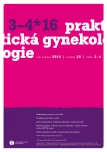-
Medical journals
- Career
Physiotherapy after gynecologic abdominal surgery
Authors: Pavla Formanová
Authors‘ workplace: Klinika rehabilitačního lékařství 3. LF UK a FN Královské Vinohrady, Praha
Published in: Prakt Gyn 2016; 20(3-4): 152-155
Category: Gynecology and Obstetrics
Overview
Physiotherapy is an integral part of all surgical fields. A physiotherapist, a specialist focusing on the locomotor organs and locomotor functions, is of course a member of the interdisciplinary team which, together with other specialists, provides postoperative care for patients. Physiotherapy in postoperative care primarily focuses on the prevention of postoperative complications. It uses techniques of respiratory rehabilitation and prevention of thromboembolism. Necessary are also daily fitness exercises of the limbs and trunk which contribute to maintaining patients’ present shape also after surgery. All rehabilitation steps are aimed at early achieving of preoperative physical fitness, that is, early verticalization and walking, to enable patients greater self-sufficiency and self-care (ADL – Activities of Daily Living) and of course strengthen their confidence. The aim of rehabilitation care is to reach the shortest possible time of hospitalization following surgery and the patient’s return to home environment and normal life. The indication for rehabilitation and its scope is in the hands of treating physicians – gynecologists, who should closely cooperate with physiotherapists in this respect.
Key words:
early verticalization – fitness exercise – obesity – postoperative physiotherapy – pulmonary rehabilitation – walking
Sources
1. Hromádková J et al. Fyzioterapie. HaH; Praha 1999. ISBN 80–86022–45–5.
2. Máček M, Smolíková L. Pohybová léčba u plicních chorob. Victoria Publishing; Praha 1995. ISBN 80–7187–010–2.
3. Haladová E et al. Léčebná tělesná výchova, cvičení. IDPVZ Brno 1997. ISBN 80–7013–236–1.
4. Kolář P et al. Rehabilitace v klinické praxi. Galén; Praha 2009. ISBN 978–80–7262–657–1.
5. Lewit K. Manipulační léčba. 5. zcela přepracované vydání. Sdělovací technika; Praha 2003. ISBN 80–86645–04–5.
6. Formanová P. Fyzioterapie po operaci prsu. Prakt.Gyn 2016; 20(1): 31–34.
7. Benda K. Lymfedém končetin v ordinaci praktického lékaře. Med Pro Praxi 2006; 3(6): 276–279.
8. Benda K. Lymfedém – komplexní fyzioterapie, lymfodrenáže a doplňující léčebná péče. NCONZO: Brno 2007. ISBN 978–80–70134–55–9.
9. Wald M, Adámek J. Proteázy v léčbě lymfedému. In: Bechyně M, Bechyňová R. Mízní otok – lymfedém: Komplexní terapie. Phlebomedica; Praha 1997 : 294–297.
10. Véle F. Vyšetření hybných funkcí z pohledu neurofyziologie. Triton; Praha 2012. ISBN 978–80–7387–608–1.
11. Kabelíková K, Vávrová M. Cvičení k obnovení a udržení svalové rovnováhy (průprava ke správnému držení těla). Garada Publishing; Praha 1997. ISBN 80–7169–384–7.
12. Kobrová J, Válka R. Terapeutické využití kinesiotapu. GradaPublishing; Praha 2012. ISBN 978–80–247–4294–6.
13. Smíšek R. Spirální stabilizace páteře Léčba a prevence bolestí zad metodou SM-systém. R. Smíšek; Praha 2009. ISBN 978–80–904292–0-8.
14. Informace dostupné na WWW: <http://www.spiralstabilization.com>.
Labels
Paediatric gynaecology Gynaecology and obstetrics Reproduction medicine
Article was published inPractical Gynecology

2016 Issue 3-4-
All articles in this issue
-
Cardiovascular changes in pregnancy II.
Preeclampsia and its long-term consequences for mother and offspring - Conservative therapy of interstitial pregnancy with the use of methotrexate – case study
- Preeclampsia today and tomorrow
- Can semi-quantitative analysis of amniotic fluid glucose be useful in gynecology and obstetrics? A pilot study.
- Pain-free childbirth in 2016
- Fear of pregnant women
- Physiotherapy after gynecologic abdominal surgery
- Selected psychometric properties of the Czech Version of the FACT-B Scale (Version 4) for Measuring Quality of Life in Breast Cancer Patients
-
Cardiovascular changes in pregnancy II.
- Practical Gynecology
- Journal archive
- Current issue
- Online only
- About the journal
Most read in this issue- Physiotherapy after gynecologic abdominal surgery
- Conservative therapy of interstitial pregnancy with the use of methotrexate – case study
- Preeclampsia today and tomorrow
- Pain-free childbirth in 2016
Login#ADS_BOTTOM_SCRIPTS#Forgotten passwordEnter the email address that you registered with. We will send you instructions on how to set a new password.
- Career

